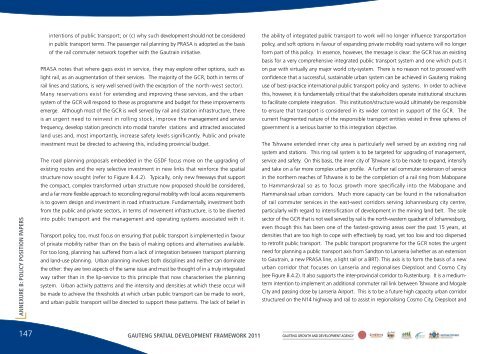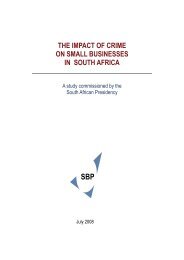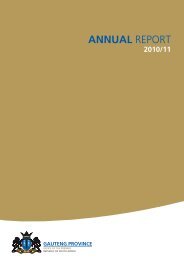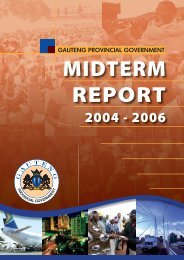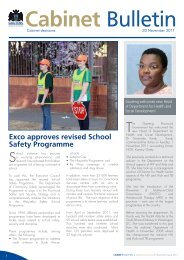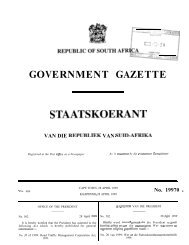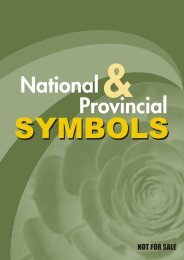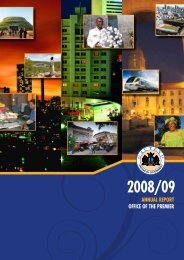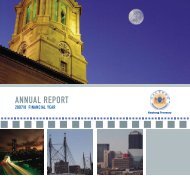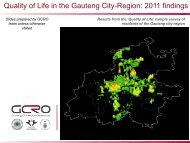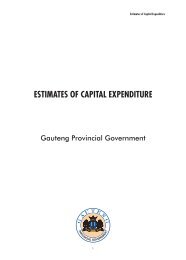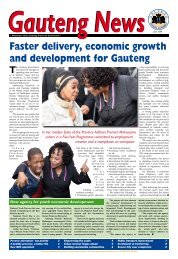the gauteng spatial development framework - Gauteng Online
the gauteng spatial development framework - Gauteng Online
the gauteng spatial development framework - Gauteng Online
Create successful ePaper yourself
Turn your PDF publications into a flip-book with our unique Google optimized e-Paper software.
ANNEXURE B: POLICY POSITION PAPERSintentions of public transport; or (c) why such <strong>development</strong> should not be consideredin public transport terms. The passenger rail planning by PRASA is adopted as <strong>the</strong> basisof <strong>the</strong> rail commuter network toge<strong>the</strong>r with <strong>the</strong> Gautrain initiative.PRASA notes that where gaps exist in service, <strong>the</strong>y may explore o<strong>the</strong>r options, such aslight rail, as an augmentation of <strong>the</strong>ir services. The majority of <strong>the</strong> GCR, both in terms ofrail lines and stations, is very well served (with <strong>the</strong> exception of <strong>the</strong> north-west sector).Many reservations exist for extending and improving <strong>the</strong>se services, and <strong>the</strong> urbansystem of <strong>the</strong> GCR will respond to <strong>the</strong>se as programme and budget for <strong>the</strong>se improvementsemerge. Although most of <strong>the</strong> GCR is well served by rail and station infrastructure, <strong>the</strong>reis an urgent need to reinvest in rolling stock, improve <strong>the</strong> management and servicefrequency, develop station precincts into modal transfer stations and attracted associatedland uses and, most importantly, increase safety levels significantly. Public and privateinvestment must be directed to achieving this, including provincial budget.The road planning proposals embedded in <strong>the</strong> GSDF focus more on <strong>the</strong> upgrading ofexisting routes and <strong>the</strong> very selective investment in new links that reinforce <strong>the</strong> <strong>spatial</strong>structure now sought (refer to Figure B.4.2). Typically, only new freeways that support<strong>the</strong> compact, complex transformed urban structure now proposed should be considered,and a far more flexible approach to reconciling regional mobility with local access requirementsis to govern design and investment in road infrastructure. Fundamentally, investment bothfrom <strong>the</strong> public and private sectors, in terms of movement infrastructure, is to be divertedinto public transport and <strong>the</strong> management and operating systems associated with it.Transport policy, too, must focus on ensuring that public transport is implemented in favourof private mobility ra<strong>the</strong>r than on <strong>the</strong> basis of making options and alternatives available.For too long, planning has suffered from a lack of integration between transport planningand land-use planning. Urban planning involves both disciplines and nei<strong>the</strong>r can dominate<strong>the</strong> o<strong>the</strong>r: <strong>the</strong>y are two aspects of <strong>the</strong> same issue and must be thought of in a truly integratedway ra<strong>the</strong>r than in <strong>the</strong> lip-service to this principle that now characterises <strong>the</strong> planningsystem. Urban activity patterns and <strong>the</strong> intensity and densities at which <strong>the</strong>se occur willbe made to achieve <strong>the</strong> thresholds at which urban public transport can be made to work,and urban public transport will be directed to support <strong>the</strong>se patterns. The lack of belief in<strong>the</strong> ability of integrated public transport to work will no longer influence transportationpolicy, and soft options in favour of expanding private mobility road systems will no longerform part of this policy. In essence, however, <strong>the</strong> message is clear: <strong>the</strong> GCR has an existingbasis for a very comprehensive integrated public transport system and one which puts iton par with virtually any major world city-system. There is no reason not to proceed withconfidence that a successful, sustainable urban system can be achieved in <strong>Gauteng</strong> makinguse of best-practice international public transport policy and systems. In order to achievethis, however, it is fundamentally critical that <strong>the</strong> stakeholders operate institutional structuresto facilitate complete integration. This institution/structure would ultimately be responsibleto ensure that transport is considered in its wider context in support of <strong>the</strong> GCR. Thecurrent fragmented nature of <strong>the</strong> responsible transport entities vested in three spheres ofgovernment is a serious barrier to this integration objective.The Tshwane extended inner city area is particularly well served by an existing ring railsystem and stations. This ring rail system is to be targeted for upgrading of management,service and safety. On this basis, <strong>the</strong> inner city of Tshwane is to be made to expand, intensifyand take on a far more complex urban profile. A fur<strong>the</strong>r rail commuter extension of servicein <strong>the</strong> nor<strong>the</strong>rn reaches of Tshwane is to be <strong>the</strong> completion of a rail ring from Mabopaneto Hammanskraal so as to focus growth more specifically into <strong>the</strong> Mabopane andHammanskraal urban corridors. Much more capacity can be found in <strong>the</strong> rationalisationof rail commuter services in <strong>the</strong> east-west corridors serving Johannesburg city centre,particularly with regard to intensification of <strong>development</strong> in <strong>the</strong> mining land belt. The solesector of <strong>the</strong> GCR that is not well served by rail is <strong>the</strong> north-western quadrant of Johannesburg,even though this has been one of <strong>the</strong> fastest-growing areas over <strong>the</strong> past 15 years, atdensities that are too high to cope with effectively by road, yet too low and too dispersedto retrofit public transport. The public transport programme for <strong>the</strong> GCR notes <strong>the</strong> urgentneed for planning a public transport axis from Sandton to Lanseria (whe<strong>the</strong>r as an extensionto Gautrain, a new PRASA line, a light rail or a BRT). This axis is to form <strong>the</strong> basis of a newurban corridor that focuses on Lanseria and regionalises Diepsloot and Cosmo City(see Figure B.4.2). It also supports <strong>the</strong> inter-provincial corridor to Rustenburg. It is a mediumtermintention to implement an additional commuter rail link between Tshwane and MogaleCity and passing close by Lanseria Airport. This is to be a future high capacity urban corridorstructured on <strong>the</strong> N14 highway and rail to assist in regionalising Cosmo City, Diepsloot and147 GAUTENG SPATIAL DEVELOPMENT FRAMEWORK 2011 GAUTENG GROWTH AND DEVELOPMENT AGENCY


